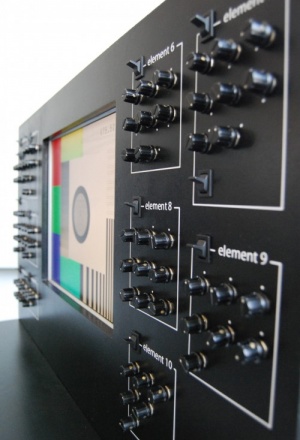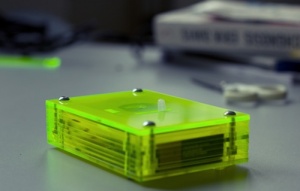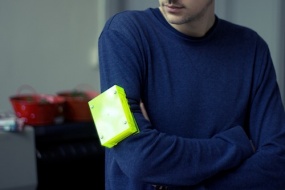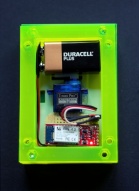Jasper van Loenen Graduation Project Proposal Final version 05.12.2012
General Introduction
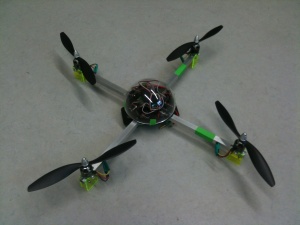
Looking for inspiration for the graduation project I focused on some of the practical projects I've done in the past - work related to my love for physical installations. I looked into some different topics like teleconferencing and AI to see if it was anything I'd like to work with, but though I do find these fields interesting they were still topics I hadn't worked with before and it felt a bit forced to continue with them.
I decided to take a side project I'd been working on for a while and use that for my graduation project. I've spent quite some time building a quadcopter, a small helicopter with four propellors - often called a UAV or unmanned aerial vehicle. At first I didn't want to use this for my graduation project because it started as something that was just for fun but after giving it some more thought, I noticed that it touches on several of the topics I was interested in when I signed up for the Networked Media course. It is something I built myself using techniques from the maker scene - in this case laser cutting and 3D printing - and all the software used is open source and is being developed by a community, in which I've become involved as well.
Apart from being an interesting project from a technical point of view, the availability of these things raises all kinds of questions, such as when and where you are allowed to use them. These questions become more and more relevant as more people build (or buy) them. Another interesting aspect is that people, as intrigued as they can be by flying things, are often just as scared of them - I've noticed this a lot when flying the quad around.
Because of this fear, I think it will be interesting to try to come up with ways to use them in a positive way. They have developed into something that is more than just a flying toy and I think it can be a platform for a whole range of activities. Already there are multiple companies using small UAVs to make aerial photos or inspect tall objects.
Since there are a lot of possibilities it will be smart to narrow down the options and focus on one particular topic at this point. When planning to build the quadcopter I was thinking of things I could to with it and one of the plans was to use it to distribute seeds. You could easily get access to inner city wastelands or hard to reach places like rooftops by just flying there and drop seeds (or maybe even small plants). In larger areas you could make a design and use GPS guide the quadcopter, dropping the seeds exactly where you want them. This way you could create large scale patterns, texts or drawings.
Apart from being a creative tool this could also be connected to the urban and guerrilla gardening communities. I can imagine that it could help to make barren places in the city greener and more friendly.
Practical Steps
My projects often start with a technical challenge and grow from there, so at the moment I'm working on a simple seed dispenser to see how it could work. After that I would like to expand it technically but also see where and by who it could be used by getting in touch with possible users.
Relation to previous practice
A lot of my work comes from a fascination with programming and electronics, and how you can use it to create new things.
One of the larger installations I made is called Test Screen and is a physical interface to connect to an abstract piece of code. The installation consists out of groups of dials and switches (96 in total) around a flatscreen monitor, set in a large (110x60cm) wooden panel. I wrote a small computer program that would display an image similar to the old television test screens and each of the dials and switches was connected to a part of the script of this program. By manipulating the controls, the audience was able to change my code and change what would be displayed. I choose to not use a generic computer with keyboard and mouse but to built a custom interface as a way to get the audience more involved, since for many using such an unknown interface is far more appealing - and telling by the time some visitors spent at the installation it worked.
The form of the object (it's size and layout of switches and dials) was based on the code you were able to change with it and wouldn't really fit any other program - it reflected the character of the system.
The same can be said for The Poking Machine (TPM), which I made together with Bartholomäus Traubeck. Facebook Users can poke each other by clicking a button on their profile pages and the recipient will receive a message saying he or she was poked. TPM is a small (9 x 7 x 5 cm) box made out of green transparent Perspex which you can strap to your upper arm using the attached piece of velcro. It will then use your phoneʼs internet connection to keep track of incoming pokes and when it detects one, a small plastic lever will come out of the box to physically poke you in the arm. This translates this meaningless written message into an actual poking gesture.
References
- P.W. Singer, (2010) Wired for War
- N. Katherine Hayles, (2005) My mother was a computer
- N. Katherine Hayles, (1999) How we became post human, virtual bodies in cybernetics, literature, and informatics
- R Barbrook (2005) Imaginary Futures,
- Where is my robot? (2008), Danny Wallace
- The Hunt for AI (2012), Marcus Du Sautoy
- Isaac Asimov

